WASHINGTON—China’s One Belt, One Road initiative is one of the world’s most ambitious and controversial development programs. Under the Trump administration, the United States is rolling out new infrastructure projects and other initiatives in the Asia-Pacific in an effort to counter China’s growing footprint in the region.
The Chinese Communist Party has made One Belt, One Road (OBOR, also known as Belt and Road) the cornerstone of its plan to expand its geopolitical influence. The initiative aims to deliver trillions of dollars of infrastructure investment to connect Asia, Europe, and Africa. The plan spans almost 70 countries and covers more than two-thirds of the world’s population.




